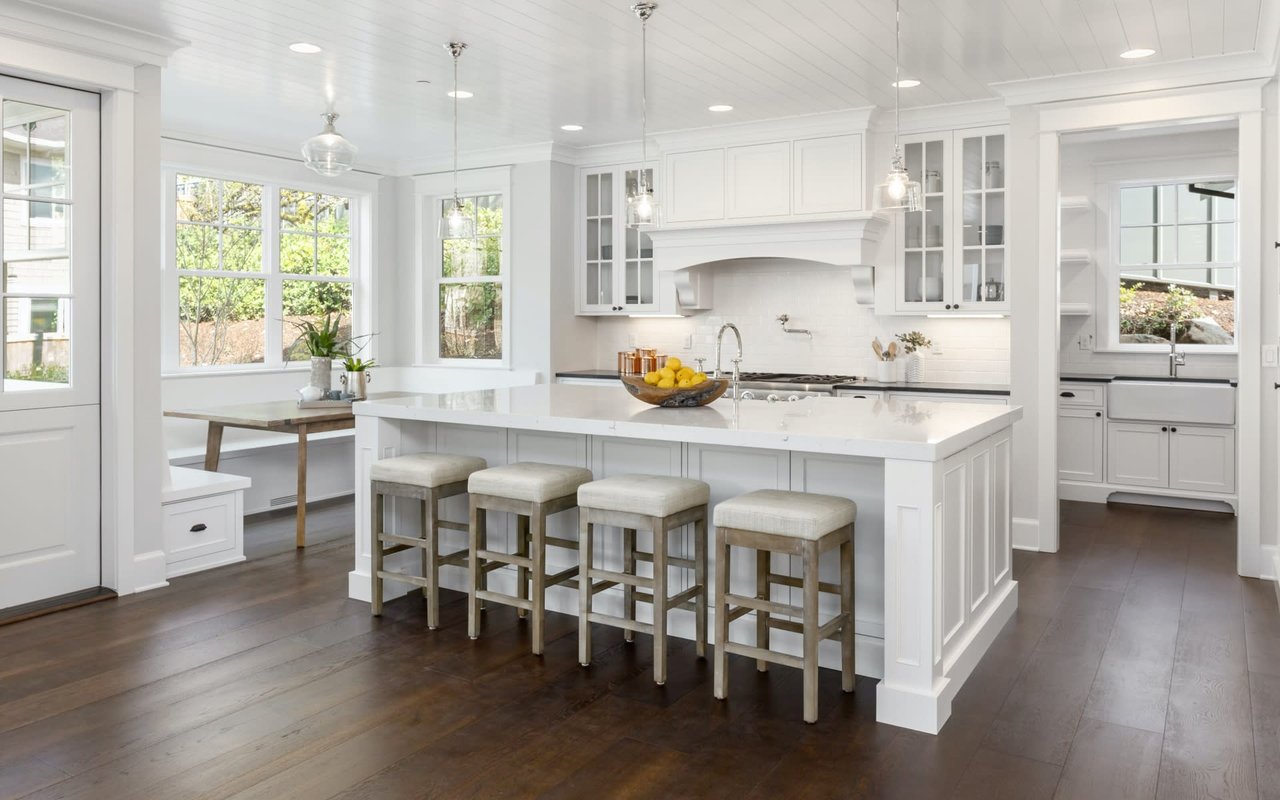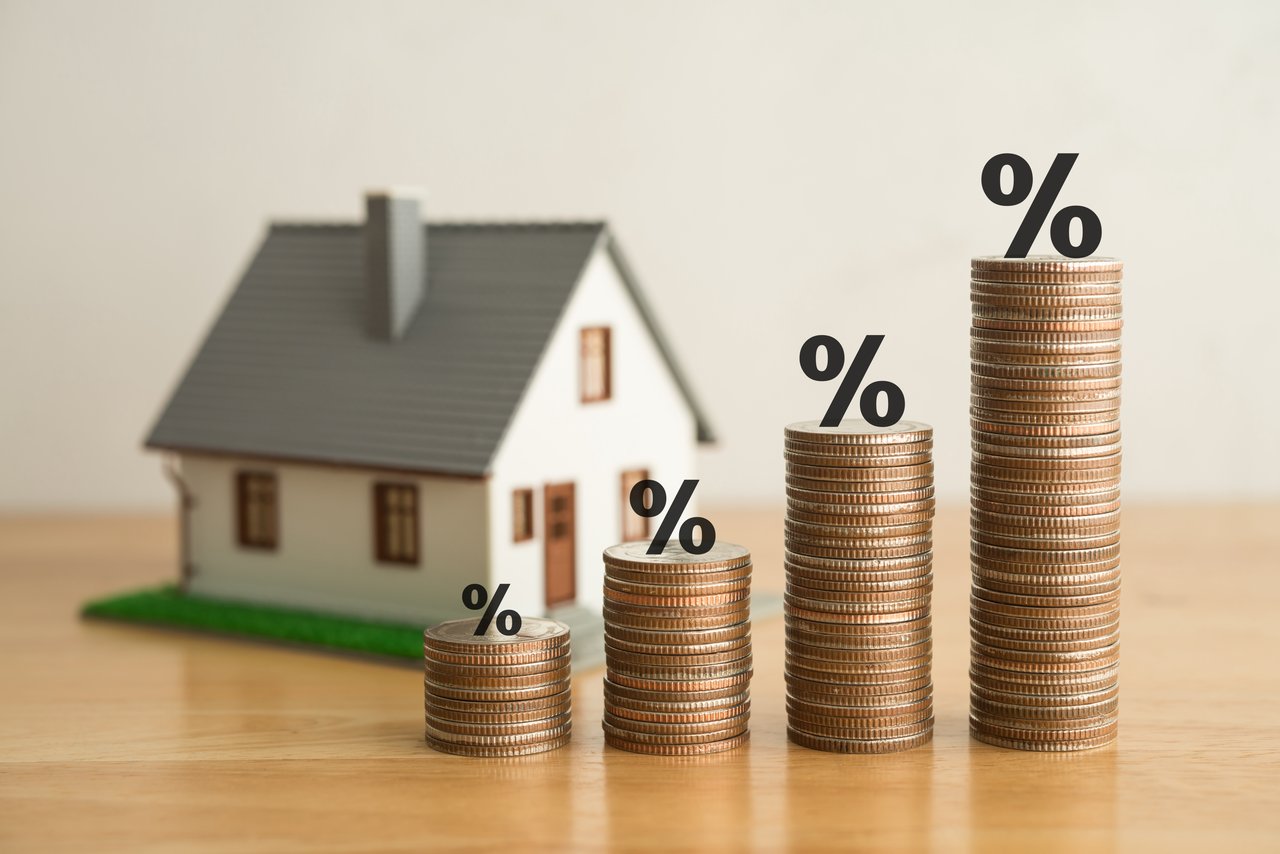You can track the Twin Cities housing market data here. You can track mortgage rates here. You can track homebuilder confidence here. You can track showing activity here. You can track lumber prices here.
Pending home sales in the Twin Cities just fell to their lowest level since December of 2007, as rising interest rates in the face of declining corporate profits continue to promote wealth destruction and housing demand destruction across U.S. markets.
When housing demand last collapsed to this extent, back in December of 2007, that particular collapse in demand signaled the beginning of a housing crash and financial crisis that would affect housing markets across the entire country and would last through 2012 (5 years). The biggest fundamental difference in the setup then vs. now is that new and existing home inventory, both locally and nationally, was much higher on both a relative basis and on an absolute basis (28,500 units in the Twin Cities in December of 2007 vs. 6,000 units today). The biggest fundamental similarity in the setup to then vs. now is that we were in the midst of the last meaningful tightening cycle (of money and credit) by the Federal Reserve following what was arguably the loosest monetary policy in U.S. history, to date, which is essentially the same scenario we face now.
Collapsing demand aside, for a meaningful crash in housing prices to set in, we believe that home inventory would first have to rise significantly from current levels, which makes home inventory a key data point to watch this year. Absent a fast and major pivot in monetary policy and a positive shift in the pending economic data (which are typically contradictory), we are expecting home inventory to rise more this year than it has in recent years, into the spring and to ultimately make new cycle highs by the late summer of 2023.
The Median Home Price: The median home price fell 1.9% in December to $348,000 as the seasonal market correction continues in most segments of the Twin Cities housing market. $348,000 is still up 4.9% YOY so the broader bullish trend in home prices has yet to be broken. Dramatic rises in mortgage rates have caused demand to collapse to its lowest level since December of 2007, but near-record low housing inventory is helping to hold prices within the broader bullish trend, despite the significant rise in the cost of capital. We expect the median home price to continue to correct through January of 2023 before turning back bullish in February of 2023.
When housing demand last collapsed to this extent, back in December of 2007, that particular collapse in demand signaled the beginning of a housing crash and financial crisis that would affect housing markets across the entire country and would last through 2012 (5 years). The biggest fundamental difference in the setup then vs. now is that new and existing home inventory, both locally and nationally, was much higher on both a relative basis and on an absolute basis (28,500 units in the Twin Cities in December of 2007 vs. 6,000 units today). The biggest fundamental similarity in the setup to then vs. now is that we were in the midst of the last meaningful tightening cycle (of money and credit) by the Federal Reserve following what was arguably the loosest monetary policy in U.S. history, to date, which is essentially the same scenario we face now.
Collapsing demand aside, for a meaningful crash in housing prices to set in, we believe that home inventory would first have to rise significantly from current levels, which makes home inventory a key data point to watch this year. Absent a fast and major pivot in monetary policy and a positive shift in the pending economic data (which are typically contradictory), we are expecting home inventory to rise more this year than it has in recent years, into the spring and to ultimately make new cycle highs by the late summer of 2023.
The Median Home Price: The median home price fell 1.9% in December to $348,000 as the seasonal market correction continues in most segments of the Twin Cities housing market. $348,000 is still up 4.9% YOY so the broader bullish trend in home prices has yet to be broken. Dramatic rises in mortgage rates have caused demand to collapse to its lowest level since December of 2007, but near-record low housing inventory is helping to hold prices within the broader bullish trend, despite the significant rise in the cost of capital. We expect the median home price to continue to correct through January of 2023 before turning back bullish in February of 2023.
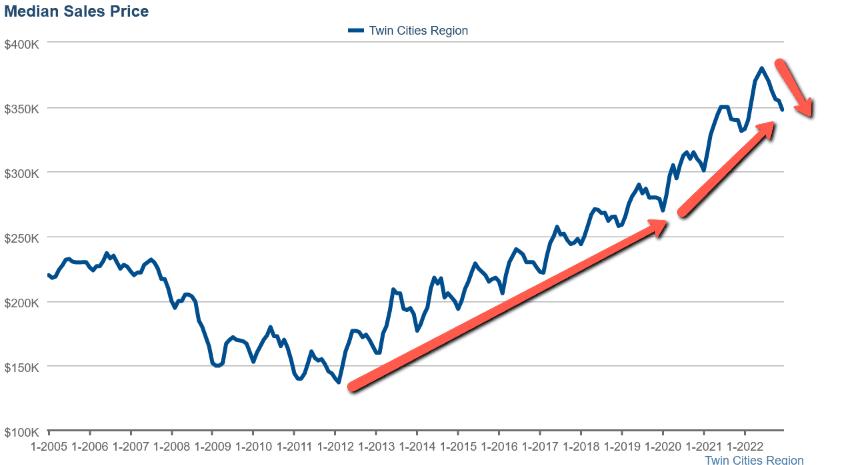
Home Inventory: The home inventory level in the Twin Cities fell 24% in December to 6,014 units (homes, condos, and townhouses). That level is also up 15% YOY but remains very low, historically. High-interest rates have put downward pressure on new listings as move-up or move-down prospects have been hesitant to trade out of a 3% mortgage for a 6%+ mortgage. The potential risk factors that could contribute to a rise in inventory down the road are 1) persistent inflation continuing to eat away at disposable income making mortgage payments harder to make or 2) the job market collapsing, which so far has been holding up, despite shrinking corporate profits. Inventory is sort of the key to the current housing market dynamic, if inventory stays low, prices are not likely to crash despite rising rates but if inventory breaks out to the upside, that would change the game.
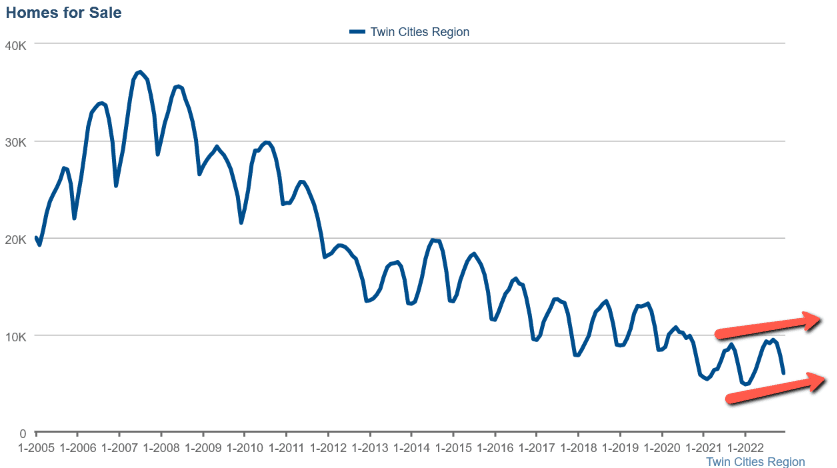
Pending Home Sales: 2,388 homes came under contract in the Twin Cities in December. That is down 16.7% MOM, down 27% YOY, and is the lowest level of demand in housing since December of 2007, which signaled a 5-year subsequent housing crash. Higher interest rates along with higher prices continue to put strain on demand and overall sales volume. We expect pending sales to continue to stay pretty flat through January before turning back up into the spring of 2023.
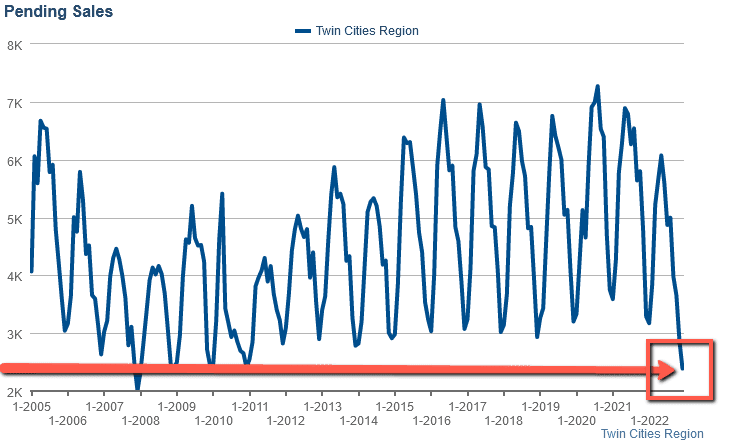
New Listings: 2,294 new listings hit the Twin Cities market in December which is down 33.8% MOM and down 11% YOY. Collapsing affordability is primarily impacting demand but it is also impacting new listings as some move up and move down buyers are deciding to stay in their current homes in the face of the higher prices and rates. With that said, pending sales have been falling at a higher rate than new listings which appears to be contributing to a larger seasonal correction in home prices than is typical.
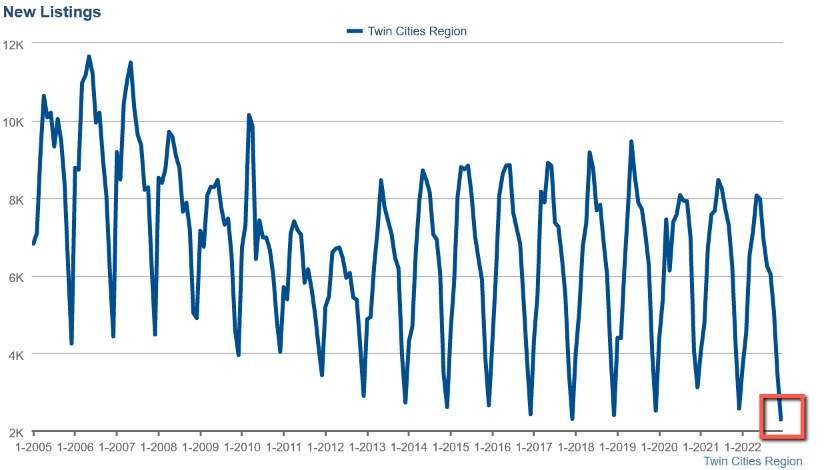
Mortgage Rates: The dramatic rise in mortgage rates has cooled off again with rates remaining flat through January but rates remain up a whopping 86% YOY. If the Fed remains committed to fighting inflation regardless of declining economic data, interest rate volatility is likely to continue into 2023.

Lumber Prices: Lumber prices have stabilized back to within a pre-pandemic range after having more than quadrupled during the pandemic and the price of lumber's impact on the housing market has resolved. Going forward, we will discontinue reporting this data unless unusual volatility in lumber prices returns.
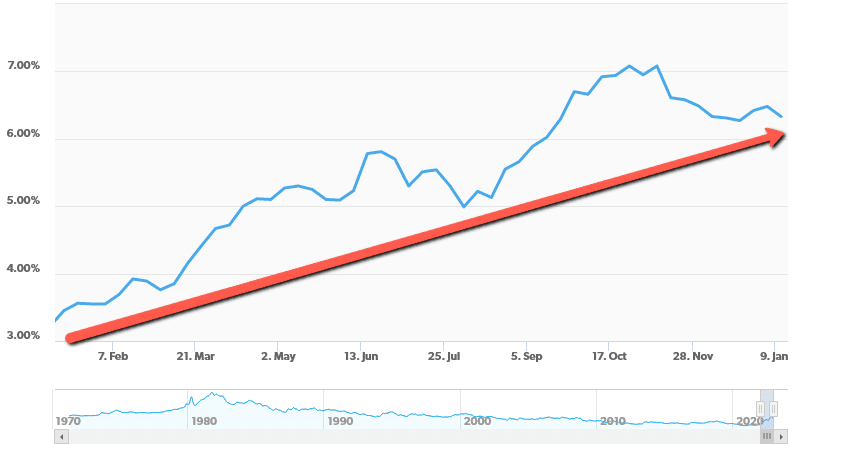
Home Builder Confidence: The NAHB housing market index in the US increased to 35 in January of 2023 from 31 in December of 2022, which was a fresh low since 2012 excluding the immediate onset of the pandemic. It is the first rise in the index since December of 2021, beating market forecasts of 31. The gauge for current sales conditions rose to 40 from 36, sales expectations in the next six months went up to 37 from 35, and traffic of prospective buyers edged 3 points higher to 23. "It appears the low point for builder sentiment in this cycle was registered in December, even as many builders continue to use a variety of incentives, including price reductions, to bolster sales. The rise in builder sentiment also means that cycle lows for permits and starts are likely near, and a rebound for home building could be underway later in 2023", ” said NAHB Chairman Jerry Konter. Source: National Association of Home Builders
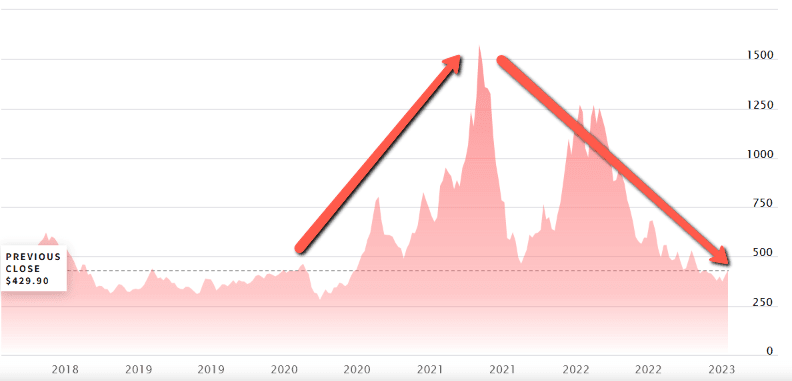
This concludes my Twin Cities housing market insight for January of 2023. Please don't hesitate to call us at (952) 222-7653 if you would like to go more in-depth on a particular market segment or dive into the current fair market value of a property that you currently own or manage.
Sources: NorthstarMLS, Infosparks Data, Hedgeeye Risk Management, FreddieMac.com, Nasdaq.com, TradingEconomics.com, fred.stlouisfed.org, The National Association of Home Builders
